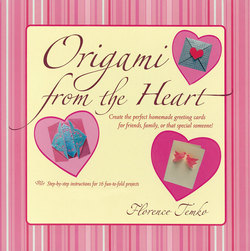Читать книгу Origami from the Heart Kit Ebook - Florence Temko - Страница 6
На сайте Литреса книга снята с продажи.
ОглавлениеIntroduction
In Origami from the Heart you will find unusual ways to send messages of love. Obviously love notes are associated with Valentine’s Day, but they can express warm feelings at any time of the year and will be welcome on many occasions as a sign of friendship.
In Origami from the Heart I have tried to combine the technique of origami—which means folding paper without cutting or gluing—with hearts, flowers, and other symbols of love to help you create fun and meaningful handmade cards. Some of them are simple enough that they can be made in a very short period of time to be sent to a whole class or office, or to a number of friends or family members. One or two, such as the Folded Money Heart, are more of a challenge, but the results will be well worthwhile.
It’s fun to create handmade cards, and doing so will give you a great feeling of satisfaction and accomplishment as well as another way of telling the recipient that you care.
—Florence Temko
About Origami from the Heart
“Origami” is a Japanese word consisting of ori meaning to fold, and gami meaning paper. According to the rules of origami, a piece of paper is transformed by using your hands as the only tool, without even scissors or glue. By this means a piece of paper can be turned into all kinds of things, such as animals, boxes, airplanes, toys, decorations, and letterfolds.
Letterfolding is an aspect of origami that will allow you to fold a sheet of paper on the spur of the moment, as an alternative to a greeting card or to highlight a page in a scrapbook with a hidden message. Many people enjoy the creative fun of folding a note in an unusual shape, knowing that the recipient will have a surprise when it is opened.
Most letterfolds in Origami from the Heart are self-closing and do not need an envelope for passing by hand. Before the nineteenth century most mail was sent in this way, folded and secured with sealing wax rather than being enclosed in an envelope. Envelopes became popular in the mid-nineteenth century when the English Post Office assessed mailings by weight and it became cheaper to send several sheets in one envelope. Previously postage was assessed by the number of sheets sent.
Since then, the sending of cards and notes has become an important tradition around the world. The custom of sending valentines on February fourteenth was especially popular in Victorian England. Printed greeting cards weren’t available, so people made their own cards by hand. These cards were usually embellished with a lot of decorative details and sent anonymously to only one person to reveal a secret love.
In Japan elaborate cards are usually attached to gifts and may be shaped into appropriate symbols. For example, cards can be folded to resemble a crane, a long-legged bird with large wings that represents longevity because of its long lifespan. The elaborateness of a design is a sign of respect afforded the recipient.
You can use Origami from the Heart as inspiration for your own note cards. In addition to this instruction book, the Origami from the Heart kit provides origami paper for cardmaking. You can further personalize your note cards by adding bits of doilies, lace, hearts, ribbons, stars, and any other small oddments. Your imagination is the essential ingredient!
Here are some appropriate messages of love you may wish to use on your note cards:
You are my valentine
You put a smile on my face
I love you
Thank you for your help
Let’s celebrate our love
Here’s a gift from my heart
I’m thinking of you
This is our day for romance
I appreciate…
Here’s a love coupon for (a big hug every day, etc)
From a distant friend
Basic Folding Information
To help you make sense of the lines and arrows on the diagrams, it will be well worth your while to take a few minutes to study the explanations of the following basic techniques that are international standards for origami.
Basic Procedures
1. Valley Fold
Folding the paper toward you is called a valley fold and is shown by a line of dashes in the diagrams.
a. Fold the square in half toward you, matching it to the opposite edge.
b. You have made a valley fold.
2. Mountain Fold
Folding paper to the back, away from you, is called a mountain fold and is shown by a line of dashes and dots in the diagrams.
a. Fold the square in half by guiding the paper to the back, matching it to the opposite edge.
b. You have made a mountain fold.
3. Existing Crease
A crease made previously is shown in the diagrams by a thin line that does not touch the edges.
4. Arrows
In the diagrams you will see four kinds of arrows. They indicate the direction in which to fold.
a. Make a valley fold.
b. Make a mountain fold.
c. Double Arrow—Fold and unfold the same crease.
d. Curly Arrow—Turn the paper over.
